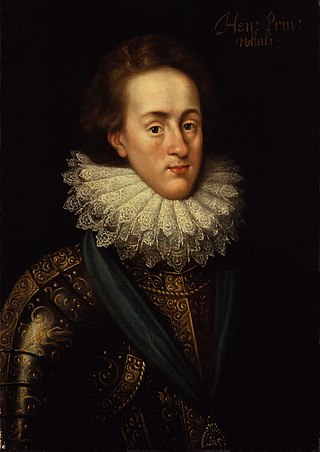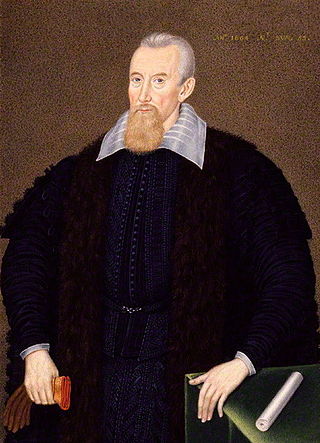Related Research Articles

Henry Frederick, Prince of Wales,, was the eldest son and heir apparent of James VI and I, King of England and Scotland; and his wife Anne of Denmark. His name derives from his grandfathers: Henry Stuart, Lord Darnley; and Frederick II of Denmark. Prince Henry was widely seen as a bright and promising heir to his father's thrones. However, at the age of 18, he predeceased his father, dying of typhoid fever. His younger brother Charles succeeded him as heir apparent to the English, Irish, and Scottish thrones.

John Erskine, 2nd Earl of Mar was a Scottish politician, the only son of another John Erskine and Annabella Murray. He is regarded as both the 19th earl and the 2nd earl.

Alexander Seton, 1st Earl of Dunfermline (1555–1622) was a Scottish lawyer, judge and politician. He served as Lord President of the Court of Session from 1598 to 1604, Lord Chancellor of Scotland from 1604 to 1622 and as a Lord High Commissioner to the Parliament of Scotland.

Ludovic Stewart, 2nd Duke of Lennox and 1st Duke of Richmond, lord of the Manor of Cobham, Kent, was a Scottish nobleman who through their paternal lines was a second cousin of King James VI of Scotland and I of England. He was involved in the Plantation of Ulster in Ireland and the colonization of Maine in New England. Richmond's Island and Cape Richmond as well as Richmond, Maine, are named after him. His magnificent monument with effigies survives in Westminster Abbey.

George Home, 1st Earl of Dunbar, KG, PC was, in the last decade of his life, the most prominent and most influential Scotsman in England. His work lay in the King's Household and in the control of the State Affairs of Scotland and he was the King's chief Scottish advisor. With the full backing and trust of King James he travelled regularly from London to Edinburgh via Berwick-upon-Tweed.
Alexander Home, 1st Earl of Home and 6th Lord Home, was a Scottish nobleman and Lord Warden-general of all the March. He succeeded as the 6th Lord Home, a Lord of Parliament in the Peerage of Scotland, in 1575, and he was created Earl of Home in the Peerage of Scotland in 1605.

Edward Bruce, 1st Lord Kinloss PC was a Scottish lawyer and judge.
Michael Balfour, 1st Lord Balfour of Burleigh PC was a Scottish peer.
Patrick Gray, 6th Lord Gray, known most of his life as Patrick, Master of Gray, was a Scottish nobleman and politician during the reigns of Mary, Queen of Scots and James VI of Scotland.

Gilles de Noailles, abbé de l'Isle (1524–1600) was French Ambassador to the Ottoman Empire from 1575 to 1579. He was the brother of his predecessor as ambassador, François de Noailles, and was succeeded by Jacques de Germigny. He was sent to the Ottoman Empire by Henry III of France.
Robert Crichton, 8th Lord Crichton of Sanquhar, was a Scottish peer executed for the murder of a fencing teacher. He was the son of Edward, Lord Sanquhar. Robert is often styled "6th Lord Sanquhar."
Sir Roger Aston of Cranford, Middlesex, was an English courtier and favourite of James VI of Scotland.
Barbara Ruthven was a Scottish courtier and favourite of Anne of Denmark, expelled from court after the death of her brother.
Sir Anthony or Antony Standen, alias Pompeo Pellegrini, English spy or intelligencer, English Catholic exile. He was recruited by Sir Francis Walsingham and provided critical information about Philip II's preparations of the Spanish Armada.

Henrietta Stewart (1573–1642) was a Scottish courtier. She was the influential favourite of the queen of Scotland, Anne of Denmark.
George Bowes was an English prospector. He mined for gold in Scotland.
Francis Mowbray or Moubray was a Scottish intriguer.
George Nicholson or Nicolson, was an English diplomat in Scotland.
John Erskine, 3rd Earl of Mar was a Scottish landowner.
Christophe de Harlay, Count of Beaumont (1570–1615) was a French politician and diplomat who served as ambassador to England.
References
- ↑ John Duncan Mackie, 'James VI and I and the Peace with Spain, 1604', The Scottish Historical Review, 23:92 (July 1926), p. 243.
- ↑ Francisque Michel, Les Ecossais en France, les Français en Ecosse, vol. 2 (Paris, 1862), p. 157.
- ↑ Jean Baptiste Alexandre Théodore Teulet, Relations Politiques de la France Et de L'Espagne Avec L'Ecosse, vol. 4 (Paris, 1862), pp. 251-8.
- ↑ Joseph Bain, Calendar of Border Papers, vol. 2 (Edinburgh, 1894), p. 793: Relations Politiques de la France Et de L'Espagne Avec L'Ecosse, vol. 4 (Paris, 1862), pp. 323-8.
- ↑ Calendar State Papers Scotland, vol. 13 (Edinburgh, 1969), p. 1031.
- ↑ Relations Politiques de la France Et de L'Espagne Avec L'Ecosse, vol. 4 (Paris, 1862), p. 329.
- ↑ Calendar State Papers Scotland, vol. 13 (Edinburgh, 1969), p. 1033-4.
- ↑ Calendar State Papers Scotland, vol. 13 (Edinburgh, 1969), pp. 1040-1.
- ↑ Calendar State Papers Scotland, vol. 9 (Edinburgh, 1915), pp. 653-6: HMC Salisbury Hatfield, vol. 12 (Hereford, 1910), p. 110.
- ↑ Calendar State Papers Scotland, vol. 13 (Edinburgh, 1969), pp. 1077-8, 1084.
- ↑ Norman Egbert McClure, The Letters of John Chamberlain, vol. 2 (Philadelphia, 1939), p. 49.
- ↑ 'The True Narration of the Entertainment of his Royal Majesty', Edward Arber, An English Garner, vol. 8 (London, 1896), p. 494: Horatio Brown, Calendar State Papers, Venice: 1603–1607, vol. 10 (London, 1900), p. 32 no. 55: Robert Chambers, The Life of King James the First, 2 (Edinburgh, 1830), p. 15.
- ↑ Memoirs of Sully.
- ↑ Horatio Brown, Calendar State Papers, Venice: 1603-1607, vol. 10 (London, 1900), p. 48 no. 73.
- ↑ Alphons Bellesheim, History of the Catholic Church in Scotland, vol. 3 (Edinburgh, 1899), p. 350.
- ↑ Horatio Brown, Calendar State Papers, Venice: 1603-1607, vol. 10 (London, 1900), p. 307 no. 462.
- ↑ John Nichols, Progresses of James the First, vol. 3 (London, 1828), p. 244.
- ↑ Allen B. Hinds, Calendar State Papers Venice: 1615-1617, vol. 14 (London, 1908), pp. 420, 436, 447, 460, 470.
- ↑ Frederick Devon, Issues of the Exchequer (London, 1836), p. 191.
- ↑ John Nichols, Progresses of James the First, vol. 3 (London 1828), p. 247.
- ↑ Norman Egbert McClure, The Letters of John Chamberlain, vol. 2 (Philadelphia, 1939), pp. 51, 55, 57.
- ↑ D. Heyward Brock & Maria Palacas, The Ben Jonson Encyclopedia (Lanham, Maryland, 2016), pp. 289-90.
- ↑ HMC Report on the Manuscripts of Earls of Mar and Kellie, vol. 2 (London, 1930), p. 74.
- ↑ G. Dynfallt Owen & Susan Anderson, HMC 75 Downshire, vol. 6 (London, 1995), p. 486.
- ↑ Marguerite Vacher, Nuns Without Cloister (Lanham, 2010), p. 31.
- ↑ Horatio Brown, Calendar State Papers, Venice: 1603–1607, vol. 10 (London, 1900), p. 32 no. 55.